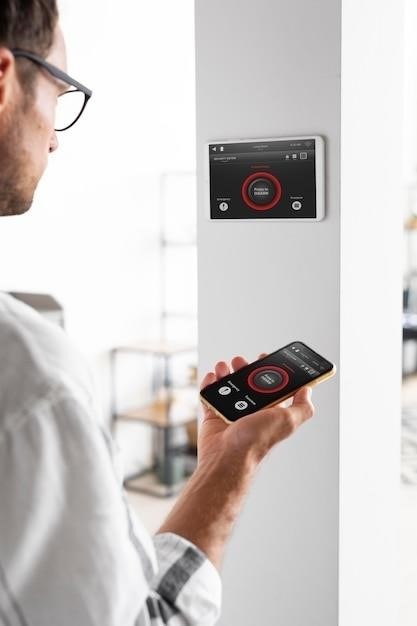Manual Fire Detection Systems⁚ A Comprehensive Guide
Manual fire detection systems are a fundamental part of fire protection in buildings. They rely on human intervention to trigger an alarm when a fire is detected. These systems are typically composed of manual call points or fire alarms, which are activated by pulling a lever or pressing a button.
Introduction
Fire safety is paramount in safeguarding lives and protecting property. A comprehensive fire safety strategy encompasses various elements, including fire prevention, detection, suppression, and evacuation procedures. Manual fire detection systems play a critical role in this strategy by providing an immediate and reliable method of alerting occupants and emergency responders to the presence of a fire. These systems are designed to be activated manually by individuals who witness a fire, allowing for a rapid response and potentially limiting the spread of the fire.
Manual fire detection systems have been an integral part of fire protection for decades, and their effectiveness has been proven in numerous instances. They offer a cost-effective and straightforward approach to fire detection, especially in areas where the risk of fire is considered moderate. This guide will delve into the intricacies of manual fire detection systems, exploring their components, operation, advantages, disadvantages, applications, and their significance in overall fire safety measures.
By understanding the nuances of manual fire detection systems, building owners, managers, and occupants can make informed decisions regarding their fire safety protocols. This knowledge is crucial for ensuring the well-being of individuals and protecting valuable assets from potential fire damage.
What is a Manual Fire Detection System?
A manual fire detection system, as the name suggests, relies on human intervention to initiate a fire alarm. Unlike automatic systems that rely on sensors to detect smoke, heat, or other fire-related conditions, manual systems require someone to physically activate the alarm. This activation is typically achieved through the use of manual call points or fire alarms, often referred to as pull stations.
These devices are strategically placed throughout a building or facility, ensuring accessibility and prompt response in case of a fire. When a fire is detected, an individual can activate the call point, triggering an audible and/or visual alarm that alerts occupants and potentially activates other components of the fire safety system, such as sprinklers or evacuation procedures.
Manual fire detection systems are often found in conjunction with automatic systems, providing a multi-layered approach to fire safety. They are particularly useful in situations where the risk of fire is considered moderate or where the environment is prone to false alarms from automatic detectors, such as kitchens or laboratories. The manual system acts as a backup, allowing for a reliable fire alarm when needed.
Components of a Manual Fire Detection System
Manual fire detection systems, while relying on human intervention, consist of essential components that work together to ensure effective fire alarm activation. These components include⁚

- Manual Call Points (MCPs)⁚ These are the primary initiating devices in a manual fire detection system. They are typically red, break-glass boxes with a lever or button inside. When activated, they send a signal to the control panel, triggering the alarm.
- Control Panel⁚ This is the central hub of the system, receiving signals from the MCPs and other components. It processes the information, activates the alarm, and may also initiate other safety measures, such as activating sprinklers or sending alerts to emergency services.
- Alarm Devices⁚ These are responsible for notifying occupants of a fire. They can include audible alarms (e.g., sirens, bells) and visual alarms (e.g., flashing lights). The type and placement of these devices depend on the specific requirements of the building and the intended audience.
- Wiring⁚ This connects all the components of the system, ensuring seamless communication between the MCPs, control panel, and alarm devices. The type and quality of wiring are crucial for reliable operation.
- Power Supply⁚ A reliable power source is essential for the system to function. This can be a dedicated battery backup system or a connection to the building’s main power grid, ensuring continuous operation even in the event of a power outage.
These components work together to form a robust and reliable manual fire detection system, providing an essential layer of fire safety in various buildings and facilities.
How Manual Fire Detection Systems Work
Manual fire detection systems operate on a simple yet effective principle⁚ human intervention triggers the alarm. When a fire is detected, an individual activates a manual call point (MCP), initiating the alarm sequence. The process typically unfolds as follows⁚
- Activation⁚ An individual spots a fire and locates the nearest MCP. They then activate the device, either by breaking the glass cover and pulling a lever or by pressing a button, depending on the MCP’s design.
- Signal Transmission⁚ Once activated, the MCP sends a signal to the control panel via dedicated wiring. This signal indicates a fire emergency.
- Control Panel Response⁚ The control panel receives the signal and processes it. It then activates the appropriate alarm devices, such as sirens, bells, and flashing lights, to alert occupants of the fire.
- Alarm Activation⁚ The designated alarm devices, based on the building’s layout and requirements, sound the alarm, notifying occupants of the fire emergency. This prompts them to evacuate the building safely and efficiently.
- Optional Features⁚ Depending on the system’s configuration, the control panel may also activate other safety measures, such as automatic sprinklers or sending alerts to emergency services. This ensures a coordinated response to the fire emergency.
The simplicity of this process makes manual fire detection systems reliable and easy to understand. They are a valuable tool for fire safety, especially in areas where the risk of fire is low or where immediate human intervention is critical for effective response.
Types of Manual Fire Alarm Initiating Devices
Manual fire alarm initiating devices, also known as manual call points (MCPs) or pull stations, are the primary components of a manual fire detection system. They are designed to be easily accessible and activated by anyone in the event of a fire. There are various types of manual fire alarm initiating devices, each with its unique characteristics and applications⁚
- Break-Glass Call Points⁚ These devices are the most common type of MCP. They consist of a glass cover that needs to be broken to activate the alarm. Once the glass is broken, a lever is pulled or a button is pressed, sending the alarm signal to the control panel.
- Push-Button Call Points⁚ Push-button call points are simpler and more user-friendly. They have a button that can be pressed to activate the alarm. These devices are often preferred for their ease of use and their lack of potential for accidental activation.
- Remote Call Points⁚ Remote call points are designed for applications where it’s necessary to activate the alarm from a distance. These devices are often used in large buildings or areas with limited access.
- Wireless Call Points⁚ Wireless call points use radio frequency signals to transmit the alarm signal to the control panel. This eliminates the need for wiring, making installation easier and more flexible.
- Addressable Call Points⁚ Addressable call points are connected to the control panel through a network, allowing the control panel to identify the exact location of the activated call point. This provides valuable information for fire response.
The choice of manual fire alarm initiating device depends on the specific needs of the building or area. Factors such as building size, layout, occupancy, and budget all play a role in determining the most appropriate type of MCP.
Advantages of Manual Fire Detection Systems
Manual fire detection systems offer several advantages, making them a valuable component of a comprehensive fire safety strategy. These advantages include⁚
- Cost-Effective⁚ Manual fire detection systems are generally less expensive to install and maintain compared to automatic systems. They require fewer components and less complex wiring, making them a budget-friendly option for many applications.
- Simple Operation⁚ Manual systems are straightforward to operate. Anyone can activate the alarm by pulling a lever or pressing a button, making them accessible to all occupants of a building.
- High Accuracy⁚ Manual fire alarms are highly accurate as they rely on human observation to trigger the alarm. This minimizes the risk of false alarms, which can be disruptive and costly.
- Suitable for Specific Environments⁚ Manual systems are well-suited for areas where the risk of fire is low or where automatic detection is impractical. For example, they are often used in small buildings, offices, and temporary structures.
- Flexibility⁚ Manual systems can be easily adapted to different building layouts and configurations. Call points can be strategically placed to ensure that every area is covered.
While manual fire detection systems have their limitations, their advantages make them a valuable tool for ensuring the safety of occupants and property in a wide range of applications.
Disadvantages of Manual Fire Detection Systems
While manual fire detection systems offer certain advantages, they also have drawbacks that must be considered. These disadvantages include⁚
- Dependence on Human Response⁚ The effectiveness of manual systems hinges on the quick and accurate response of individuals. If occupants are unaware of the fire, are incapacitated, or fail to react promptly, the alarm may not be activated in time, potentially delaying evacuation and increasing the risk of injuries or fatalities.
- Limited Coverage⁚ Manual systems rely on the placement of call points, which may not be strategically located to detect fires in every area of a building. This can lead to delayed detection and response, particularly in large or complex structures.
- Susceptibility to False Alarms⁚ While manual systems are generally accurate, they are still susceptible to false alarms. Malicious activation, accidental activation, or misinterpretation of events can trigger an alarm unnecessarily, causing disruption and inconvenience.
- Lack of Continuous Monitoring⁚ Manual systems do not provide continuous monitoring for fire hazards. They only activate when a fire is visually detected by an occupant, potentially allowing a fire to grow undetected until it becomes a significant threat.
- Limited Integration⁚ Manual systems are typically less integrated with other fire safety components, such as sprinkler systems or automatic fire suppression systems. This can limit their effectiveness in a comprehensive fire safety strategy.
These disadvantages highlight the importance of carefully considering the limitations of manual fire detection systems and evaluating the need for a more comprehensive fire safety solution, potentially incorporating automatic detection or other integrated components.
Applications of Manual Fire Detection Systems
Manual fire detection systems find their niche in various settings, often serving as a cost-effective and reliable solution for specific applications. Here are some common applications⁚
- Small Businesses and Residential Properties⁚ In smaller buildings with limited space and budget, manual fire alarm systems can provide basic fire detection and warning capabilities, fulfilling basic safety requirements.
- Temporary Structures and Construction Sites⁚ Manual fire alarms are ideal for temporary structures, such as construction sites, where permanent systems may not be feasible. They offer a simple and portable solution for raising the alarm in case of fire.
- Supplementary Systems⁚ Manual systems can serve as a supplementary measure in conjunction with automatic fire detection systems. They offer an additional layer of protection, particularly in areas where automatic detection might be challenging or limited.
- Specific Environments⁚ Manual systems are sometimes preferred in environments where the presence of dust, fumes, or other conditions might compromise the effectiveness of automatic detectors. These environments may include workshops, garages, or industrial settings.
- Outdoor Areas⁚ Manual fire alarms are often used in outdoor areas, such as campgrounds, picnic areas, or outdoor events, where the need for fire detection is essential but the installation of automatic systems may be impractical.
The versatility of manual fire detection systems allows them to be used in a variety of settings, providing a basic level of fire protection where more complex systems may not be required or feasible.
